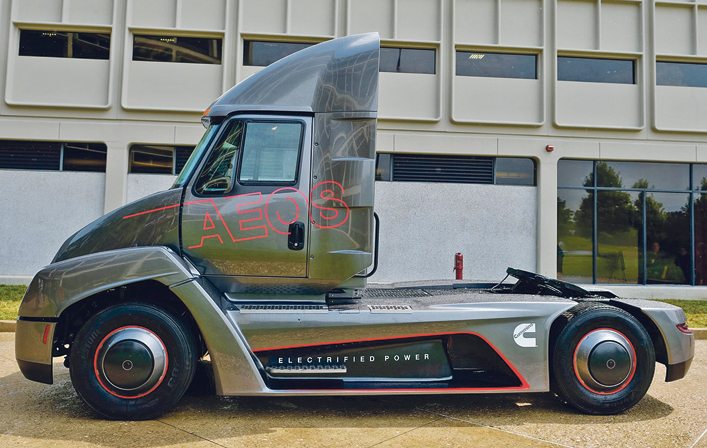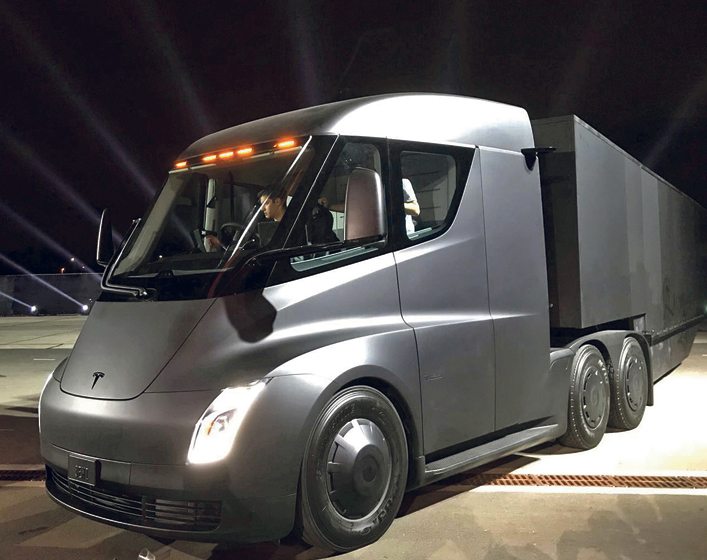Looking forward into the new year is an opportunity to imagine what might be, and Western Producer technology analyst Ron Lyseng is taking a look at the big trucks that might silently be sneaking up on the hauling market. Who knows, they might be moving from groceries to grain and fertilizer in the not too distant future.
The race to be first with an all-electric highway semi tractor was a close one, with Cummins, Mercedes, Tesla and California newcomer Thor nearly tied as they introduced their truck concepts last year. Being “first” doesn’t necessarily mean “best,” nor does it necessarily give you a jump on the market. Nonetheless, it’s a prize all of these companies have focused on and poured money into for at least the past five years.
Why the big switch to electric highway tractors? The obvious reason is that environmental regulations will continue their tightening trend as far into the future as we can see. Electric power, especially with solar-powered battery chargers, solve all those environmental and sustainability issues.
Read Also

Saskatchewan project sees intercrop, cover crop benefit
An Indigenous-led Living Lab has been researching regenerative techniques is encouraging producers to consider incorporating intercrops and cover crops with their rotations.
However, electric trucks go nowhere without a strong economic incentive.
The industry has become accustomed to getting a million miles or more on a truck. Experts say electric trucks should last a lot longer because they don’t use the high-stress moving components found in diesel engines, exhaust clean-up systems, mechanical transmissions and differentials. Electric trucks will cost less per mile to maintain and far less to run than those that burn fossil fuel.
Safety for the driver and the public is another benefit. The battery packs are located low to the ground and securely locked within the frame. This gives the semi a lower centre of gravity and better handling.
The all-electric concept trucks unveiled this year are probably very close to the real-world versions expected to go into production within the next few years.
Cummins AEOS Class 7
Cummins unveiled its AEOS Concept Class 7 Urban Hauler EV with a light weight denser battery pack that holds a longer charge for improved range and faster charging. It has a range of about 150 kilometres on a single charge for city driving. It can do 450 km with additional battery packs.

The concept truck hedges somewhat on the all-electric claim because it includes an engine-generator option for extended range.
Cummins says the combination creates a 50 percent fuel savings compared to other diesel hybrids. A truck can be classified as fully carbon neutral only if the charging power is generated from 100 percent renewable sources.
The AEOS has a 140 KWh battery pack instead of a 12 litre diesel engine. Weight of the electric power train is approximately the same as the conventional power train it replaces. The electric setup eliminates the diesel engine, exhaust treatment, transmission and fuel tank. The tractor day cab has a gross vehicle weight-rating limit of 75,000 pounds.
The concept vehicle uses a regenerative braking system that creates electrical energy and sends it to the battery pack. Solar panels on the trailer roof can send additional energy to the battery pack. There is a significant reduction in air drag because of the highly streamlined form, better sealed truck body and underbody, and elimination of the front radiator.
Tesla Semi
Tesla has been in the electric vehicle business the longest, so it’s logical it may be a step or two ahead of the competition.
The company says its electric semi outperforms diesel rivals in terms of responsiveness and handling with safer operation in and around regular traffic. It says it can cover more miles than a diesel in the same time period.

To maximize production efficiency, the Tesla Semi uses components from its Model 3 electric car, including individual Model 3 motors for each wheel. With production of Model 3 now hitting 5,000 cars per week, Tesla says its supply chain can easily channel many common components into the semi truck line.
However, the company’s semi highway tractor design is totally new and unique. The cabin is designed for easy access, and the driver can fully stand when inside it. The driver’s seat is centred in the cab, and the removable passenger jump seat is offset and behind the main driver position. A touch screen is positioned on either side of the driver, providing navigation information, blind spot monitoring, trip data logging and a suite of fleet management and routing tools.
The truck has a range of 550 km on a single 30-minute charge, which can be done while loading and unloading by detaching the cab. The power comes from Tesla solar-powered Megachargers. Tesla plans to locate them worldwide to ensure that people can travel electrically from Point A to Point B without a charging issue.
Semi uses a special battery design that reinforces the battery units and lowers the truck’s centre of gravity by positioning them low in the chassis. The truck is designed to reduce jackknifing by automatically detecting instability and then applying power or braking force to each wheel accordingly to the need. The windshield glass is engineered to resist impacts.
Tesla has been a pioneer in developing innovative driver assistance features on its lineup of consumer cars. On the Semi, it uses Enhanced Autopilot, which provides automated emergency braking, lane keeping and lane departure warnings to help encourage safe highway driving.
The Semi introduced by Tesla this fall is a day truck, but it can easily extend to accommodate a sleeper cabin and a longer underlying battery pack. A huge factor for truck owners is that Tesla has a standard million mile warranty against breakdowns.
Mercedes Urban eTruck
Mercedes-Benz says that its new Urban eTruck is capable of hauling 23.5 tonnes and has a 200 km range, produce zero local emissions and makes a fraction of the noise created by traditional diesel vehicles.
The company says it’s the first fully electric truck designed for heavy distribution. The Urban eTruck has three lithium-ion battery modules built into the frame, sending power to electric motors located inside the hubs of the rear tires.
“Electric drive systems previously only saw extremely limited use in trucks,” says Wolfgang Bernhard of Daimler.
“Costs, performance and charging times develop further so rapidly that the time now is ripe for the electric truck.”
The concept truck is scheduled to enter customer trials this year, and Mercedes expects to have the technology ready for city streets worldwide by early next decade.
Thor Trucks revealed its first all-electric semi in mid-December, and the company claims some competitive specifications, making it a longer-haul competitor for Tesla and Mercedes.
With an output of up to 700 horsepower, the ET-One can handle mountainous terrain with a load.
Thor Trucks ET-One
Thor’s ET-One will have a 300 km range and an 80,000 lb. gross weight, and the company claims a 70 percent operating cost savings. At a predicted price for the ET-One of US$150,000 to $250,000, the truck will be a consideration even for traditional hauling.
The ET-One recharges in just 90 minutes after a six hour trip, but the company suggests it will be first targeting short-haul markets of 350 km.
Loblaw goes electric
The giant Canadian-owned Loblaw grocery chain is converting to fully electric and hybrid big rigs across the country.
The company unveiled its first Class 8 electric heavy hauler this past fall. Built by electric vehicle pioneer BYD, the truck will be based on iron-phosphorous battery technology that has been pushing the Chinese company’s electric buses around since 2009.
In a news release, Loblaw said its new 53-foot truck is the first step in its effort to slash diesel emissions across its sprawling supply chain by converting its fleet to fully electric or hybrid trucks. The 482 h.p. electric truck will pull a hybrid refrigerated trailer.
The truck has a gross combination weight rating of 120,000 lb. and can travel 125 km on a single charge with a 2.5 hour recharging cycle.
Loblaw said it plans to roll out the new electric vehicle and refrigeration technology on a wider scale in the coming years.
















